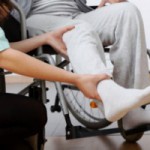 Occupational therapy has been around since 1917, but most people still get confused as to what it is. I’ve compiled a list of common myths about occupational therapy to clarify what it isn’t.
Occupational therapy has been around since 1917, but most people still get confused as to what it is. I’ve compiled a list of common myths about occupational therapy to clarify what it isn’t.
#1 “OTs help people get jobs.”
Not exactly. OTs only help people get jobs if a client’s goal is to gain employment, which is more likely seen in a vocational center or working with clients with substance abuse or mental health issues. The term “occupations” refers to the everyday activities people do while simply living life.
It might include helping clients find a new way to prepare food after a serious bike accident or helping a toddler hold their bottle independently. To learn about the myriad of roles occupational therapists have, check out Occupational Therapy is More than Learning How to Eat Again.
#2 “OTs are physical therapists of the hand.”
Ehhh, not quite. This hits two myths in one. First, the job of an OT is not limited to the hands any more than a chef’s is limited to a spatula. OTs help clients work on goals related to visual-motor issues, sensory processing, dressing and bathing, ergonomics, using adaptive equipment and more.
Second, while it may look similar to an outsider, PTs and OTs have distinct roles. This blog lays out some of the biggest differences between PTs and OTs.
#3 “So kids don’t need occupational therapy, right?”
Wrong! First I’ll refer you to #1. A kid’s occupation is essentially developing, playing and learning. Kids might be having issues reaching milestones or becoming independent in certain activities like eating or tying shoes.
If they’re really struggling, OT might be necessary to give them that one on one time and support so they don’t fall too far behind.
#4 “OTs only work in the medical setting.”
While medical knowledge (anatomy, neuroscience, etc) is a huge part of our training, we don’t only work in medical practice areas. Occupational therapists can work in homes, schools, day programs, residential facilities and or as professionals in offices.
We might work as consultants, or work in academia at universities. This recent post lays out some of the most common practice settings for OTs. And we expand our settings over time depending on where we are needed.
#5 OTs mostly help people learn to dress and bathe.”
That can be part of an OTs job role, especially in acute care or with older adults. But that’s certainly not what all OTs do. We teach the importance of movement breaks, utilizing calming strategies, strengthening their core and improving posture.
We break down activities so a client learns to do it independently. OTs help clients learn how to use a different, more efficient hand grasp. We teach strategies for improved focus, eye-hand coordination and for safer homes and accessible environments. We teach task efficiency and energy conservation.
We recommend ways to protect vulnerable joints or broken bones. Depending on what a client needs, an OT’s role can expand depending on the day.
These myths highlight only a few of the misconceptions surrounding occupational therapy. It can be difficult to identify what occupational therapy is by name alone, but through greater exposure and myth debunking, people can gain a clearer picture of what it means to be an OT.







